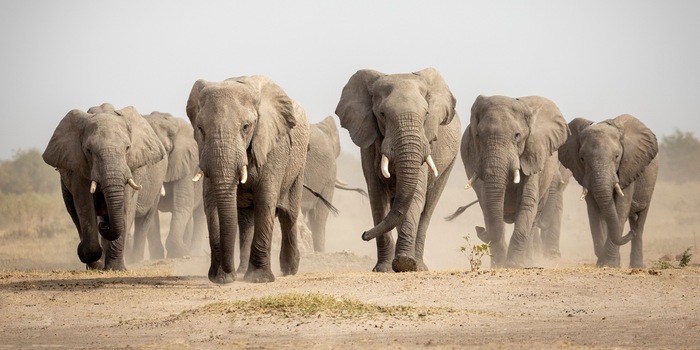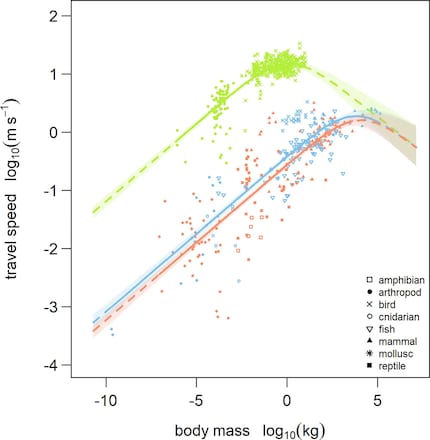
Lame giants
The giants of the animal kingdom move relatively slowly. This may reduce their chances of survival in today's environment.
Large animals tend to move more slowly than medium-sized animals - otherwise they would overheat. This is the conclusion reached by a research team led by Alexander Dyer from Friedrich Schiller University Jena. The scientists have carried out theoretical calculations and analysed experimental data from several hundred animal species. They report on this in the scientific journal "PLoS Biology".
The larger a creature is, the longer and stronger its locomotor organs usually are - whether they are legs, wings or fins. Longer and stronger extremities allow for more expansive movements, which is why larger animals should be able to move faster than smaller ones. This is the case, but only up to about medium stature. If the body mass increases further, the speed of locomotion remains the same or even decreases again. Fin whales (around 70 tonnes) travel at an average speed of around 9 kilometres per hour, while the much more impressive blue whales (around 140 tonnes) only travel at 7.5 kilometres per hour.
Critical temperatures
Why is that? Dyer and his team provide an explanation: large organisms do not get rid of their body heat as quickly as small ones. This is because the longer an organism increases in surface area to the second power, while its volume increases to the third power. Heat is generated throughout the entire volume, but only flows outwards via the surface. This is why giants are more at risk of overheating than dwarfs
Dyer & Co have developed a mathematical model with which they can calculate the endurance speed of flying, running and swimming animals. The equations take into account the mass of the creature in question; they also contain terms that describe the heat exchange with the environment and the efficiency of locomotion in air, water or on land. Using this formula apparatus, the team determined the migration speeds of various animal species and obtained a hump-shaped curve: Medium-sized organisms are the fastest, while lighter and heavier organisms are slower. When the researchers compared the calculated correlation with measured data from several hundred species, there was good agreement in the range for which empirical values were available.

Source: Dyer, A. et al.: The travel speeds of large animals are limited by their heat-dissipation capacities. Plos Biology 21, E3001820, 2023, Fig. 2 / CC by 4.0 CC by
"Muscles have an efficiency of perhaps 20 to 30 per cent," says Dyer, "which means that 70 to 80 per cent of the metabolic energy expended is converted into heat." Because large creatures release this heat more slowly into the environment than small ones, they have to take more breaks to cool down. "Above a certain body weight, this increasingly limits the distance that can be travelled per time."
In an environment characterised by human intervention, this may have a detrimental effect. Natural biotopes are disintegrating into ever smaller pieces as a result of logging, road construction, agriculture and colonisation. "Large animals need a lot of habitat and have to bridge the distances between these patches," says Myriam Hirt from Friedrich Schiller University Jena, who was involved in the study. "They could react more sensitively to the ongoing fragmentation of the landscape and climate change than previously assumed - and therefore be more threatened with extinction than previously thought."
Spectrum of science
We are partners of Spektrum der Wissenschaft and want to make well-founded information more accessible to you. Follow Spektrum der Wissenschaft if you like the articles.
[[small:]]
Cover image: Shutterstock / Stu Proter
Experts from science and research report on the latest findings in their fields – competent, authentic and comprehensible.